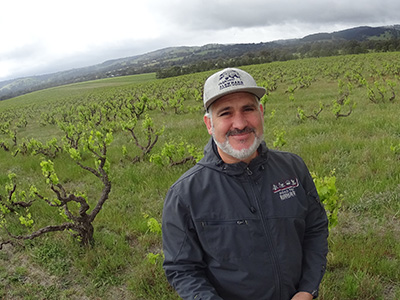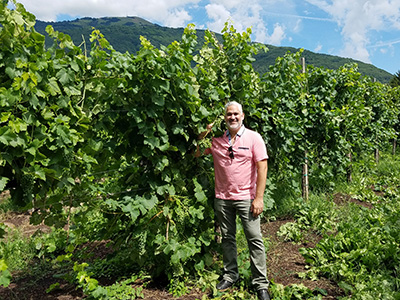
Maurice DiMarino at Seppeltsfield Port winery in Australia, founded in 1851, drinking a port from his birth year, 1971.
“Homework always involves tasting wine. One cannot taste enough,” says Maurice DiMarino, an instructor in San Diego State University’s Business of Wine Professional Certificate program. A certified sommelier, this gleeful advocate of wine and joie de vivre in general teaches California Wines, Spanish Wines, South American Wines, and Sensory Evaluation.
Also a certified cicerone, DiMarino is the beverage director for Cohn Restaurant Group and oversees 22 local restaurants. He answered some questions about his career and his SDSU courses.
Please give us a brief history of your education and career.
I studied art and film at UCSD, SDSU, and finally finished my B.A. at SFSU. During this time I worked in restaurants to pay my way through college. Unknowingly, I was doing on-the-job-training all those years. After graduating, I continued with the restaurant business because it gave me the flexibility to pursue art and travel. Travelling was my post-graduate work; it opened my eyes to the world around me and I took a greater interest in other cultures and their wines. I eventually worked my way from a cook, cashier, food runner, server, bartender, bar manager, GM, and now beverage director for Cohn Restaurant Group.

Maurice DiMarino among the Veneto Prosecco vines in the vineyards owned by Domus Vini, the winery where he made a Pinot Grigio for CRG called Marevento.
What does your typical day look like as beverage director?
Every day is always a different day. The time of year usually dictates my focus in my day-to-day activities. The beginning of the year I focus on partnerships and programs with our suppliers. I create a beverage program which can be utilized across the 22 different restaurants. It’s a challenge, since each restaurant has a different concept. I empower my beverage managers to buy the wines/beers/spirits they think would work in their restaurants. During this time I spend a lot of time doing cocktail development and guiding them with their wine choices. Other times of the year I focus on education. I go to each restaurant and host beverage training. I also host three different six-week courses each year for all employees, covering spirits, beer and wine. Other times of the year my focus is on events and promotions. I create a calendar for the year utilizing my supplier partnerships and host events, dinners, and classes intended for our guests in each restaurant. I also need to sift through an endless amount of new, innovative products and see which are worthwhile for our restaurants. You would not believe how many cocktail mixers exist!
How did you come to be an instructor with SDSU’s Business of Wine program and when did you start?
I took a job in 2005 at Island Prime as the wine director. A bit later, I met William Bixby, the then-dean of SDSU Global Campus. He was in the process in building the Wine Professional Certificate program. He added me to the board but I was never really involved. Jump forward to 2013 when I was enrolled in the Craft Beer program, I was asked to teach a California Wine class. So I did, and I am now teaching four classes. I love it!
Please give us an overview of each of the four courses you teach.
California Wines: Learn the history of our great wine region — some that is forgotten or never mentioned in almost all California wine books. Learn how it developed and what the future has in store for it.
Spanish Wines: Discover new grape varieties and regions most people have never heard of let alone tasted. Spanish wines are some of the most approachable old world wines for the new world palate. It’s challenging when approaching it from an academic stand point, but so rewarding as an experience.
South American Wines: South American wines are becoming very well known for Chilean Cab and Argentine Malbec, but there is so much more. The fun part of this course is since South America is based on such an influence from Spain, I throw in a short section on the wines from Mexico. Being so close to the emerging region, it’s great to get a better perspective on it.
Wine Sensory Evaluation: This class allows students to learn not only how to better taste and describe wine, but they learn something new about themselves and their senses. Definitely my favorite class to teach. If I can get one more day added on to this class, we can discover the senses we have forgotten to use when tasting wine: hearing and sight.

Maurice Di Marino among the 100-year-old, bio dynamically farmed vines of the McLaren Vale at Yangarra in Australia.
What do you think are the wine program’s biggest strengths?
I think the biggest strength is its accessibility. People always ask me, “How can I learn more about wine?” I never knew how to answer since I learned over a period of time and never went to school for it. I did not even know wine schools existed. My standard answer was, “Buy The Wine Bible and drink French wine.” However, that has changed. I can now say, “Register for the SDSU Business of Wine Professional Certificate program.”
What did you want to be when you grew up?
Indiana Jones.
What would students be surprised to learn about you?
I could not be Indiana Jones — archaeology was more boring than I had expected — so instead I changed my direction in life to be the Karate Kid. I studied for many years and received a black belt and started after-school programs at three different elementary schools. That ended when I moved to San Francisco and was hit by the wine bug. (Not phyloxerra …)
Anything you’d like to add?
I am lucky to be able to pursue my hobby while working. I’m always learning something new and I need to stay sharp and on top of my industry. I’m super excited to share what I know with anyone willing to hear.




